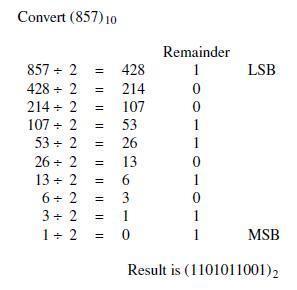Question: In Figure 1.6 we show how to convert a decimal number into binary by successively dividing by 2. Another way to derive the answer is
In Figure 1.6 we show how to convert a decimal number into binary by successively dividing by 2. Another way to derive the answer is to construct the number by using powers of 2. For example, if we wish to convert the number (23)10, then the largest power of 2 that is not larger than 23 is 24 = 16. Hence, the binary number will have five bits and the most significant bit is b4 = 1. We then perform the subtraction 23 − 16 = 7. Now, the largest power of 2 that is not larger than 7 is 22 = 4. Hence, b3 = 0 (because 23 = 8 is larger than 7) and b2 = 1. Continuing this process gives
23 = 16 + 4 + 2 + 1
= 24 + 22 + 21 + 20
= 10000 + 00100 + 00010 + 00001
= 10111

Using this method, convert the following decimal numbers into binary.
(a) (17)10
(b) (33)10
(c) (67)10
(d) (130)10
(e) (2560)10
(f) (51200)10
Convert (857) 10 857 + 2 = 428 2 214 + 2 107 + 2 53 2 26 + 2 13 + 2 6+ 2 3+2 1 + 2 = 428 214 107 53 26 13 6 3 1 0 Remainder 1 0 0 1 1 0 1 0 1 1 LSB MSB Result is (1101011001).
Step by Step Solution
3.45 Rating (168 Votes )
There are 3 Steps involved in it
a 17 16 1 24 20 10001 in binary b 33 32 1 25 20 100001 ... View full answer

Get step-by-step solutions from verified subject matter experts


